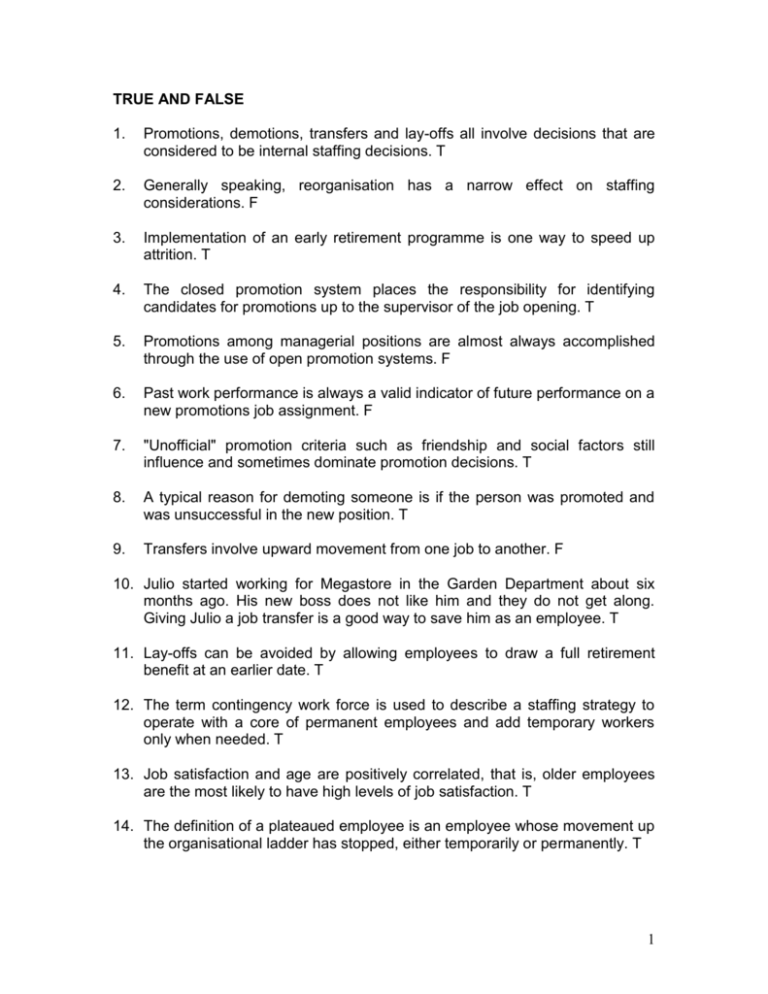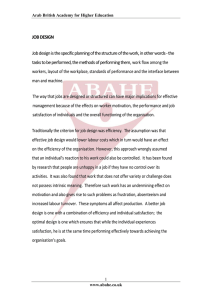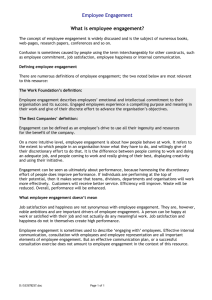File
advertisement

TRUE AND FALSE 1. Promotions, demotions, transfers and lay-offs all involve decisions that are considered to be internal staffing decisions. T 2. Generally speaking, reorganisation has a narrow effect on staffing considerations. F 3. Implementation of an early retirement programme is one way to speed up attrition. T 4. The closed promotion system places the responsibility for identifying candidates for promotions up to the supervisor of the job opening. T 5. Promotions among managerial positions are almost always accomplished through the use of open promotion systems. F 6. Past work performance is always a valid indicator of future performance on a new promotions job assignment. F 7. "Unofficial" promotion criteria such as friendship and social factors still influence and sometimes dominate promotion decisions. T 8. A typical reason for demoting someone is if the person was promoted and was unsuccessful in the new position. T 9. Transfers involve upward movement from one job to another. F 10. Julio started working for Megastore in the Garden Department about six months ago. His new boss does not like him and they do not get along. Giving Julio a job transfer is a good way to save him as an employee. T 11. Lay-offs can be avoided by allowing employees to draw a full retirement benefit at an earlier date. T 12. The term contingency work force is used to describe a staffing strategy to operate with a core of permanent employees and add temporary workers only when needed. T 13. Job satisfaction and age are positively correlated, that is, older employees are the most likely to have high levels of job satisfaction. T 14. The definition of a plateaued employee is an employee whose movement up the organisational ladder has stopped, either temporarily or permanently. T 1 15. Glass ceiling is defined as artificial barriers based on bias that prevent qualified individuals from advancing into management level in their organisations. T 16. Career management is largely a one-time planning exercise to match the needs of employees and organisations. F 17. Individual employees are responsible for initiating their own career planning. T 18. Career management can benefit managers by enhancing their reputations as people-developers. T 19. If career management is to succeed, it must receive the complete support of top management. T 20. Career management focuses on the needs of a firm's employees above and beyond the needs of the organisation. F 21. It is the responsibility of the employee to identify his/her own knowledge, skills, abilities, interests and values and to seek out information about career options in order to set goals and develop career plans. T 22. It is the responsibility of the organisation to supply information about its mission, policies and plans for providing support for employee selfassessment, training and development. T 23. Because individuals change over time, they cannot have a perfect understanding of where they are headed, but can have a perfect understanding of where the organisation is going. F 24. With careful planning, many or most careers will progress in a rational progression of positions. F 25. Dual career paths provide for progression in special areas with compensation that is comparable to that received by managers at different levels. T 26. Performance appraisals help identify good performers, but these employees are often not good candidates for promotion. F 27. In an assessment centre, individuals are evaluated as they participate in a series of situations that resemble those they might be called upon to handle on the job. T 28. Assessment centre exercises favour those who are strongest in technical and practical skills. F 2 29. An assessment centre is generally viewed as having validity, fairness, and job relatedness. T 30. Assessment centres use in-basket exercises to gauge the technical skills of employees. F 31. During the early career stages of career management, individuals attempt to obtain job offers from desired organisations. F 32. Experiencing a career plateau is an usual occurrence. F 33. There is little an employer can do to help an employee who is in a job for which the likelihood of promotion is slim. F 34. Organisation-centered career planning focuses on finding opportunities for career growth within the organisational structure. F 35. The purpose of succession charts is to document who will temporarily take over responsibilities if the person in charge is unavailable. F 36. The career management process is an intermittent activity that begins with initial induction. F 37. Performance appraisal systems assist in determining employee strengths and weaknesses. T 38. Career management is not as critical as it once was. F 39. Line managers are infrequently used to conduct career management programmes. F 40. HR professionals are typically responsible management programmes. T for coordinating career 41. From the organisation's viewpoint, career management increases costs, but it does increase employee satisfaction. F 42. While skills and abilities could be added and/or refined through additional training/development individuals should be realistic when engaging in selfassessment, and consider only current abilities as input to career management. F 43. Traditionally, the most frequently used source for input to employee assessment by the organisation has been performance appraisal. T 3 44. Employees with degrees never reach a plateau in their careers. F 45. One should emphasise his/her strengths and not be too concerned about weaknesses. F 46. Good subordinates do not always make good managers. T 47. Career planning is only done by large companies. F 48. The company and the labour union of the employee should plan and develop an individual's career. F 49. If an employee has a career plan, he/she is more likely to experience job satisfaction. T 50. Organisation loyalty is now stronger than ever. F 4










